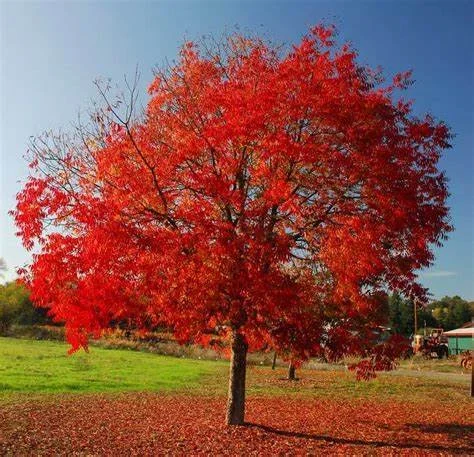Sissoo Trees: The Good, The Bad, and The Ugly
Few trees stir as much debate among landscapers, arborists, and homeowners as the Sissoo tree. Known scientifically as Dalbergia sissoo, this fast-growing hardwood tree has a dual personality: it’s praised for its beauty, shade, and environmental benefits — but also cursed for its aggressive roots, invasiveness, and maintenance challenges.
We will dive into the pros and cons of the Sissoo tree to help you decide whether it’s a dream or a disaster in your landscape.
What Is a Sissoo Tree?
The Sissoo tree, sometimes called Indian Rosewood, belongs to the Fabaceae family and thrives in warm climates. In recent years, it’s been widely planted in the southern United States — especially Arizona, California, and Texas.
Its key characteristics:
Fast growth rate: Can grow 3–5 feet per year.
Height: Mature trees reach 40–60 feet tall.
Appearance: Deciduous leaves with a beautiful, light canopy; somewhat symmetrical, upright shape.
Wood: Extremely durable and used for high-end furniture and flooring.
Why People Love the Sissoo Tree
1. Shade and Cooling Benefits
Sissoo trees grow quickly and form a dense canopy, making them one of the most efficient shade trees available. In hot, arid climates, this makes a significant difference in cooling down homes, parks, and streets.
In urban planning, Sissoos have been used to reduce heat islands — areas where temperatures are significantly higher due to concrete and asphalt.
2. Low Water Needs Once Established
Despite their leafy canopy, Sissoo trees are drought-tolerant once established. This is a major advantage in places like Arizona and California where water conservation is a priority.
3. Wind and Pollution Tolerance
Thanks to its strong root system and hardy wood, the Sissoo tree is wind-resistant and can survive in polluted urban environments. It's often planted along highways and busy streets for this reason.
4. Ecological Benefits
As a legume, Sissoo is a nitrogen-fixing tree. This means it naturally enriches the soil by converting atmospheric nitrogen into a usable form for plants. It also provides habitat for birds and insects and contributes positively to biodiversity.
5. Aesthetic Appeal
Its light green, glossy leaves and upright growth give it a neat, elegant look. Homeowners often favor it for front yards or avenues, where its beauty and symmetry can shine.
Difficulties the Sissoo Tree
Despite these positives, the Sissoo has a dark side that’s caused plenty of frustration among homeowners, landscapers, and even city governments.
1. Invasive Root System
The number one complaint about Sissoo trees is their aggressive, shallow root system. These roots can:
Crack sidewalks and driveways
Damage home foundations
Uplift patios, walls, and pavement
Invade septic tanks and water pipes
Even trees planted 15–20 feet away from structures can cause issues over time.
2. Suckering and Spreading
Sissoo trees are known for producing suckers — shoots that pop up from the roots, often several feet away from the main tree. These shoots can rapidly spread, leading to an unwanted “forest” of Sissoo if not constantly pruned.
In some communities, this suckering habit has caused them to be labeled “invasive” or “nuisance” plants.
3. Rapid Growth = Constant Maintenance
While their fast growth is appealing at first, it also means Sissoo trees require:
Regular pruning (at least once or twice a year)
Clean-up of fallen leaves and twigs
Structural maintenance to prevent breakage
Neglected Sissoo trees can grow unstable or become top-heavy, posing safety risks during storms or high winds.
4. Allergy Concerns
Although not extremely allergenic, Sissoo trees can trigger allergies due to their pollen and shedding leaves. The issue is compounded when planted in dense urban areas.
5. Bans and Legal Battles
Some cities have gone as far as banning the planting of Sissoo trees or encouraging their removal from residential areas. In Scottsdale, Arizona, for example, the city received dozens of complaints and legal threats over Sissoo-related property damage.
Case Studies: Where Sissoo Trees Went Wrong
Residential Nightmare in Arizona
A homeowner in Phoenix shared that a single Sissoo tree planted in the front yard sprouted more than 50 suckers in neighboring yards. Despite cutting the tree down and applying herbicide, the roots continued to send up new shoots for two years.
Municipal Headaches
Some city planners once saw Sissoos as a perfect shade solution. Now, they face expensive removal and infrastructure repairs after Sissoo roots damaged sidewalks, sewage lines, and curbs.
Sissoo Tree Alternatives
If you love the idea of a fast-growing shade tree but want fewer headaches, consider these alternatives:
Chitalpa
Hybrid of Catalpa and Desert Willow
Drought-tolerant, medium-sized
Attractive flowers, non-invasive roots
Desert Museum Palo Verde
Native to the Southwest
Gorgeous yellow flowers
Deep roots, little maintenance
Chinese Pistache
Brilliant fall color
Moderate growth rate
Low maintenance and non-invasive
Texas Ebony
Dense evergreen foliage
Great for privacy and shade
Slow growing but low-risk
Tips for Managing Existing Sissoo Trees
If you already have a Sissoo tree (or several), here’s how to keep them under control:
Routine pruning: Keep the canopy light and balanced to reduce breakage and suckering.
Remove suckers early and regularly.
Avoid overwatering: Encourages further root spread and sucker growth.
Professional help: Consult with certified arborists who specialize in root management.
Is the Sissoo Tree Right for You?
Ultimately, the answer depends on your specific context.
If you have the space and time to manage it well, the Sissoo tree can be an asset. But for many homeowners, its root aggression and suckering habit simply aren’t worth the risk.
Conclusion: Beauty or Beast?
The Sissoo tree embodies a classic landscaping dilemma: function vs. control. It grows rapidly, offers shade, and thrives in tough conditions — but it does so at a cost.
Whether it's loved for its benefits or hated for its complications, the Sissoo tree teaches an important lesson in landscaping: always do your homework before planting. What seems like a quick solution may turn into a long-term challenge.





